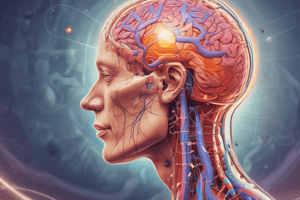Podcast
Questions and Answers
Which type of pain serves as a warning of dysfunction and leads to protective behavioral changes?
Which type of pain serves as a warning of dysfunction and leads to protective behavioral changes?
- Chronic pain
- Acute pain (correct)
- Cancer-related pain
- Neuropathic pain
Which type of pain does not serve a biological function and imposes severe detrimental stress?
Which type of pain does not serve a biological function and imposes severe detrimental stress?
- Neuropathic pain
- Chronic pain (correct)
- Acute pain
- Cancer-related pain
Which type of pain can be the result of primary tumor growth, metastatic disease, or adverse effects of chemotherapy and radiation treatment?
Which type of pain can be the result of primary tumor growth, metastatic disease, or adverse effects of chemotherapy and radiation treatment?
- Cancer-related pain (correct)
- Neuropathic pain
- Acute pain
- Chronic pain
Which type of pain originates from injury or post-injury damage to the central or peripheral nervous systems and is possibly associated with motor, sensory, or autonomic deficits?
Which type of pain originates from injury or post-injury damage to the central or peripheral nervous systems and is possibly associated with motor, sensory, or autonomic deficits?
What is the process of converting stimuli into an action potential or nerve signal at the level of specialized receptors or free nerve endings?
What is the process of converting stimuli into an action potential or nerve signal at the level of specialized receptors or free nerve endings?
Which type of fibers transmit immediate sharp pain due to their small diameter and thin myelin sheath?
Which type of fibers transmit immediate sharp pain due to their small diameter and thin myelin sheath?
What is the process of augmenting or suppressing nociceptive information?
What is the process of augmenting or suppressing nociceptive information?
Where do A-delta and C-fibers mainly terminate in the spinal cord's dorsal horn?
Where do A-delta and C-fibers mainly terminate in the spinal cord's dorsal horn?
What refers to the neuroanatomic changes that result in heightened or exaggerated pain states?
What refers to the neuroanatomic changes that result in heightened or exaggerated pain states?
Why is the efficacy of opioids especially limited in exaggerated pain states?
Why is the efficacy of opioids especially limited in exaggerated pain states?
Flashcards are hidden until you start studying
Study Notes
Pain Types
- Nociceptive pain serves as a warning of dysfunction and leads to protective behavioral changes.
- Pathological pain does not serve a biological function and imposes severe detrimental stress.
Cancer Pain
- Cancer pain can be the result of primary tumor growth, metastatic disease, or adverse effects of chemotherapy and radiation treatment.
Neuropathic Pain
- Neuropathic pain originates from injury or post-injury damage to the central or peripheral nervous systems and is possibly associated with motor, sensory, or autonomic deficits.
Transduction
- Transduction is the process of converting stimuli into an action potential or nerve signal at the level of specialized receptors or free nerve endings.
Nerve Fibers
- A-delta fibers transmit immediate sharp pain due to their small diameter and thin myelin sheath.
Modulation
- Modulation is the process of augmenting or suppressing nociceptive information.
Neuroanatomy
- A-delta and C-fibers mainly terminate in the spinal cord's dorsal horn.
Central Sensitization
- Central sensitization refers to the neuroanatomic changes that result in heightened or exaggerated pain states.
Opioid Efficacy
- The efficacy of opioids is especially limited in exaggerated pain states due to central sensitization.
Studying That Suits You
Use AI to generate personalized quizzes and flashcards to suit your learning preferences.




